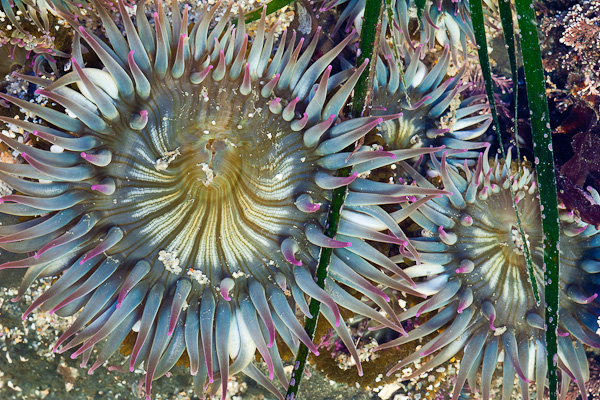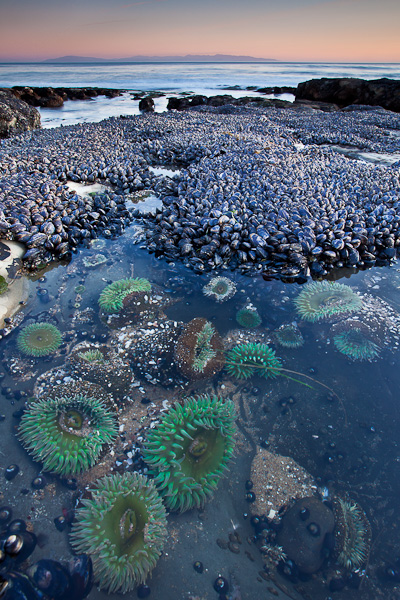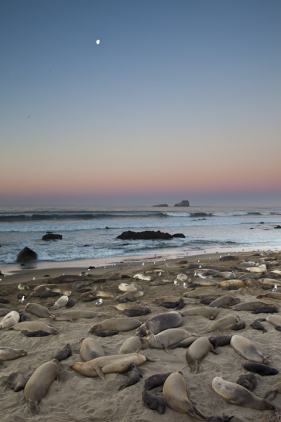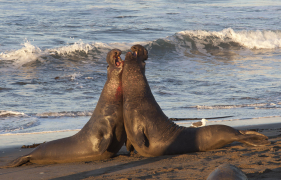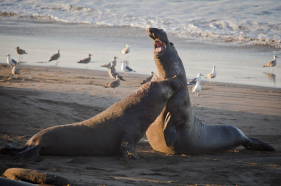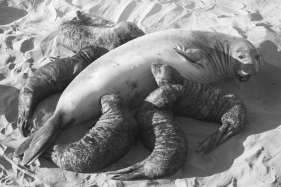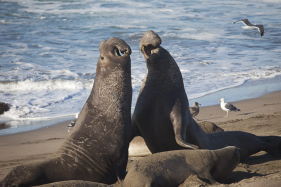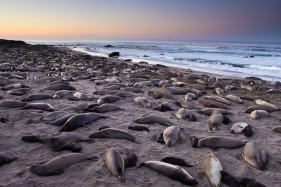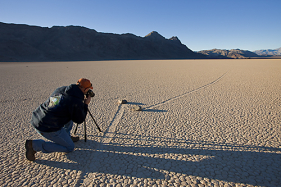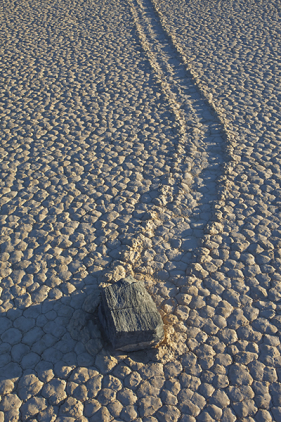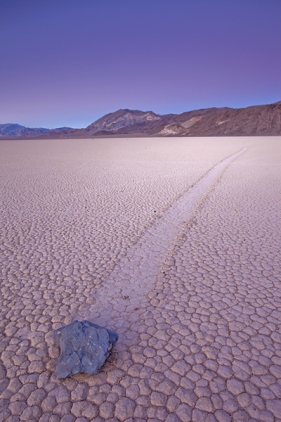With negative tides happening late in the day, the weekend was spent tidepooling at Natural Bridges in Santa Cruz, and Fitzgerald Marine Reserve just North of Half Moon Bay. Tidepool photography can be especially challenging since most of the interesting activity is happening a couple of feet underwater in dark little pools. Not the best lighting conditions by any stretch. My goal setting out was to capture tidepool life as part of the surrounding landscape with nice sunset light in the sky. Not too much to ask for I’d say. In 2 days of poking around I found only one pool that set up the way I envisioned. I was able to include the Monterey Peninsula at the south end of the Bay along the horizon line as an added bonus.
Look for a collection of my bird photographs in the upcoming Santa Cruz County Bank’s Birds of a Feather exhibit that kicks off later this month. This exhibit runs in conjunction with the Monterey Bay Birding Festival and will focus on the varied habits and habitats of birds on the Central Coast. The exhibit will include my work along with 6 other local artists.
You’ll be able to see the work by visiting Santa Cruz County Banks in Aptos, Capitola, Santa Cruz, Scotts Valley and Watsonville.
There will be a Reception and Mixer August 3rd from 5-7 pm at Santa Cruz County Bank, 595 Auto Center Drive, Watsonville.
A couple of weeks ago I had the pleasure of assisting my good friend Jason Bradley with his annual elephant seal workshop. Our trip was timed to coincide with the peak of activity at the rookery near San Simeon. It’s truly one of North America’s most spectacular wildlife experiences. On a typical day you can expect to see several thousand seals on the beach, vicious territorial battles between males, mating, nursing pups, and possibly a handful of births. This year we had the rare opportunity to witness a small sea lion sneak into the rookery and feed off a nursing mother alongside her pup. The mom did notice something was a bit off, but allowed the sea lion to nurse for a few minutes before chasing it off. For more info about these amazing marine mammals and the rookery… http://www.elephantseal.org/
Recently took a quick trip to Point Reyes National Seashore. This is a video from my partner in crime, Jason Bradley.
Join us for our Encore Weekend of Open Studios
We’ll be open 10:00 am – 5:00 pm

Come on down to Capitola this weekend and see what’s new.
September 11 & 12. 10am – 6pm. As usual you can catch the shuttle from the Capitola Mall on 41st.
 Next month I’ll be teaching a photo workshop for young budding photographers. The workshop is February 6th – an early session for 5-8 year olds and an afternoon session for 9-13 year olds. We’ll be out at the Marina Library in Monterey County. For more information go to: Monterey Peninsula Regional Park District’s website or contact me.
Next month I’ll be teaching a photo workshop for young budding photographers. The workshop is February 6th – an early session for 5-8 year olds and an afternoon session for 9-13 year olds. We’ll be out at the Marina Library in Monterey County. For more information go to: Monterey Peninsula Regional Park District’s website or contact me.
Over the New Years holiday, I had the opportunity to visit Death Valley National Park. Having not been there before I had a lot of ground to cover with my partner in crime (Scott Arnaz) in just 2 1/2 days. We hit a lot of the major sites including the famous Mesquite Sand Dunes, Artist’s Palette, Zabriskie Point, Devil’s Golfcourse, and the Salt Flats near Badwater.
Particularly impressive was our visit to the remote Racetrack playa which is home to the mysterious sliding rocks. The playa is nestled between the Cottonwood Mountains to the east and the Last Chance Range to the west. During periods of heavy rain, water washes down from nearby mountain slopes onto the playa, forming a shallow, short-lived lake. Under the hot Death Valley sun, the thin veneer of water quickly evaporates, leaving behind a layer of soft mud. As the mud dries, it shrinks and cracks into a mosaic of interlocking polygons.
Strewn across the playa are rocks of various sizes, some weighing several hundred pounds, which leave long tracks in the sediment. Some of these tracks are in a straight line, but many make sharp changes of direction, long bending curves, or multiple twists and turns. There are several theories as to what causes the rocks to move. The predominent explanation is that during storms with accompanying high winds the rocks get blown around the slick, rain soaked playa and are subject to the multiple directional shifts of the wind. No one knows for sure since this phenomema has never been witnessed, but it certainly seems to be the most logical explanation.

